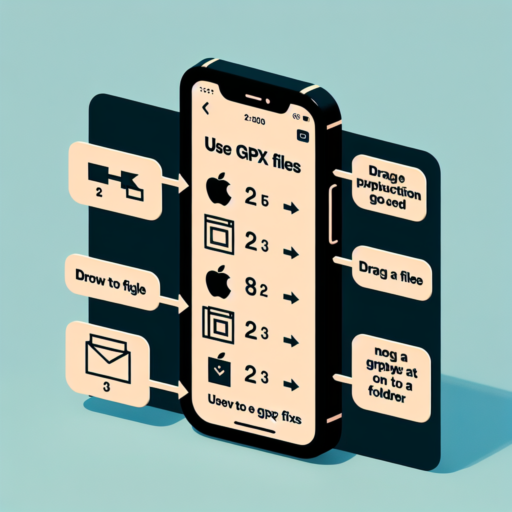No se han encontrado productos.
Introduction to Using GPX Files on Your iPhone
Exploring the great outdoors or navigating through unfamiliar streets has never been easier with the advent of GPX files on your iPhone. GPX, which stands for GPS Exchange Format, is a type of XML file format designed for storing GPS data. This data can include routes, waypoints, and tracks, making it incredibly useful for a variety of outdoor activities such as hiking, biking, geocaching, and more. In this brief introduction, we’ll delve into the benefits of using GPX files on your iPhone and how they can enhance your navigational experiences.
First and foremost, using GPX files allows for precise and customizable navigation. Unlike traditional maps or even some digital mapping systems, GPX files enable users to follow a specific route or track with high accuracy. This is particularly beneficial for activities where following a predetermined path is crucial. Additionally, for adventurers and explorers, GPX files open up a world of sharing and discovering new trails and waypoints contributed by a global community of users.
Another significant advantage of GPX files is their versatility and compatibility with various iPhone applications. Numerous apps available on the App Store can import and export GPX files, thus making it easy for users to switch between apps while maintaining their preferred routes and tracks. This seamless integration enhances the user experience by providing a range of tools and functionalities, all while using the universal GPX format.
Step-by-Step Guide on How to Import GPX Files to iPhone
Importing GPX files to your iPhone might seem like a complex task, but it’s actually quite straightforward once you understand the steps involved. GPX files, commonly used for storing GPS data like waypoints, routes, and tracks, are vital for adventurers, cyclists, and anyone in need of detailed geographical navigation. Whether you’re looking to import trails for your next hiking adventure or routes for a cycling event, this guide simplifies the process for iPhone users.
Step 1: Choose a Compatible Application
Before you can begin importing GPX files into your iPhone, you’ll need to select a compatible application. Several third-party apps like GPX Viewer, Maps 3D, and Strava offer seamless GPX file integration. These apps not only help you to import but also to view and interact with your GPX data effectively. Choosing the right app depends on your specific needs, such as whether you’re more focused on navigation, fitness tracking, or simply exploring new trails.
Step 2: Transfer the GPX File to Your iPhone
Transferring the GPX file to your iPhone can be done in a few different ways, with email being one of the simplest. Simply email the GPX file to yourself, open the email on your iPhone, and tap on the attachment. Most GPS-apps will recognize the GPX file and offer to open it directly. Alternatively, you can use cloud storage services like Dropbox or iCloud Drive. Upload the GPX file to your chosen service, access it from your iPhone, and open it with your preferred GPS application.
Step 3: Import the GPX File into Your App
Once you’ve successfully transferred the GPX file to your iPhone, the next step is to import it into your chosen application. This usually involves opening the app, navigating to its import section or menu, and selecting the GPX file. Some apps may prompt you to confirm the import and allow you to preview the data before finalizing. After the import is complete, your GPX data will be readily accessible, allowing you to start your adventure without delay.
Top Apps for Accessing and Using GPX Files on iOS
Sure, focusing strictly on the specified H2 topic, let’s explore the content:
Accessing and using GPX files on iOS has become increasingly popular among outdoor enthusiasts, cyclists, and travelers who value precise navigation and track recording. With the vast array of applications available on the App Store, it can be overwhelming to find the one that best fits your needs. However, several standout apps have proven their worth through user-friendly interfaces, comprehensive features, and reliable performance. Whether you are planning your next big adventure or simply enjoy tracking your daily walks, these top apps will help you make the most out of your GPX files.
GPX Viewer and Recorder is a prime example, offering a robust solution for not only viewing but also recording your tracks. Its straightforward design ensures you spend less time figuring out the app and more time exploring. With features like offline maps and customizable data fields, it caters to both casual users and seasoned adventurers.
For those who prioritize integration with other services, MapOut is another excellent choice. This app allows users to import and export GPX files seamlessly, making it easier to share your routes or follow along with others’ journeys. Its unique map styling and intuitive interface elevate the mapping experience on iOS devices.
Lastly, Trail Router stands out for its innovative approach to route planning. By generating routes based on user preferences for scenery and elevation, it takes the guesswork out of planning your next outing. Its compatibility with GPX files ensures you can save, share, and revisit your routes whenever you desire.
How to Share and Export GPX Files from Your iPhone
Sharing and exporting GPX files from your iPhone can enhance your fitness tracking and outdoor navigation experiences. GPX, or GPS Exchange Format, is a widely-used format for storing geographical information, such as waypoints, routes, and tracks. Whether you’re an avid hiker, cyclist, or someone who loves to keep track of your outdoor activities, learning how to share and export these files can be incredibly useful.
Initiating the Export Process begins with finding the right app that supports GPX file export. Many GPS and fitness apps on the iPhone have this functionality built-in. After completing your activity, look for a sharing or export option within the app. This is typically found in the activity or route details page. Select the GPX format when prompted, as this will ensure compatibility with a wide range of mapping software and services.
Sharing GPX Files can be done directly from your iPhone through various means. Once you have exported the GPX file, you can share it via email, messages, or through cloud storage services like iCloud or Dropbox. For users looking to collaborate or share their adventures, this ease of transfer can significantly enhance the collective experience. Furthermore, sharing these files allows others to explore the same routes or analyze the data for their own training purposes.
Troubleshooting Common Issues with GPX Files on iOS
Dealing with GPX files on iOS devices can sometimes present challenges that leave users scratching their heads. Whether you’re a hiking enthusiast trying to track your routes or a developer testing app features, encountering issues can disrupt your workflow. Nevertheless, several common problems have well-documented solutions that can get you back on track swiftly.
Identifying Common GPX File Issues
First and foremost, it’s crucial to pinpoint the problem you’re experiencing. Users often report issues such as the inability to import GPX files into certain apps, corrupted files leading to inaccurate tracking, or the iOS device failing to recognize the file format altogether. Understanding the nature of the issue is the first step toward resolution.
Step-by-Step Solutions
- App Compatibility: Ensure the app you’re trying to use supports GPX files. Not all apps do, so consulting the app’s documentation is a good starting point.
- File Integrity: Corrupted GPX files won’t function as expected. Use online tools to validate your file’s integrity or try opening it with a different app to diagnose the issue.
- Updating iOS: Sometimes, the root of the problem lies in the operating system itself. Make sure your iOS device is running the latest version, as compatibility improvements are continually being made.
Advantages of Using GPX Files for Navigation and Tracking
GPX files, or GPS Exchange Format files, have become a cornerstone for outdoor enthusiasts and professionals alike, who rely on precise navigation and tracking. The advantages of utilizing GPX files in various applications are manifold, offering benefits that cater to both the need for accuracy and the desire for simplicity in navigation tasks.
Enhanced Compatibility Across Platforms
One of the significant advantages of GPX files is their wide compatibility across numerous devices and applications. Whether you’re using a smartphone, a handheld GPS unit, or a sophisticated mapping software on your computer, GPX files can seamlessly integrate with these tools. This universal applicability ensures that users can share and use these files across different platforms without worrying about file format conversions, enabling a smoother and more efficient navigation experience.
Accurate and Detailed Tracking
GPX files excel in providing detailed tracking of routes, waypoints, and tracks. This ability to record exhaustive details such as elevation, speed, and direction, in addition to the basic longitude and latitude, makes GPX files indispensable for activities that demand a high level of accuracy. Hikers, cyclists, and sailors, among others, find this precision crucial for planning routes, analyzing performance, and ensuring safety during their journeys. The depth of data captured by GPX files enhances the user’s situational awareness, making navigation and tracking activities more insightful and reliable.
Easy Sharing and Collaboration
Another notable advantage of using GPX files is the facilitation of easy sharing and collaboration among users. With GPX files, sharing routes, waypoints, and tracks with others is straightforward, enabling collaborative trip planning or analysis sessions. This aspect of GPX files is especially beneficial for group expeditions and activities, where multiple participants can contribute their insights and corrections to a shared navigation plan. The simplicity with which GPX files can be shared helps in fostering a collaborative spirit, ensuring that all participants are well-informed and aligned with the planned routes and objectives.
Customizing Your Experience: Tips and Tricks for GPX Files on iPhone
Exploring the world of GPX files on your iPhone can significantly enhance your mapping and tracking experiences. Whether you’re an avid hiker, a road trip enthusiast, or someone who loves to keep a detailed log of your journeys, understanding how to effectively use GPX files can be a game-changer. In this guide, we delve into some invaluable tips and tricks to help you customize and maximize the utility of GPX files.
Importing and Managing GPX Files on Your iPhone
The first step to utilizing GPX files is mastering the import and management process. For iPhone users, various apps facilitate this, but choosing one that seamlessly integrates with your device’s ecosystem is key. iOS’s Files app serves as a central hub for managing these files, allowing you to easily import them from emails, web downloads, or direct file transfers. Once imported, organizing your GPX files into designated folders can streamline your access and use during outdoor adventures or trip planning.
Optimizing Your Mapping Apps for GPX Usage
Unlocking the full potential of GPX files also involves optimizing your preferred mapping applications. Many third-party apps support GPX file integration, enhancing your navigation with custom waypoints, routes, and tracks. Applications like Google Maps and Apple Maps have varying degrees of GPX support, with several workarounds available to ensure compatibility. Exploring these options can drastically improve your navigation experiences, providing personalized maps tailored to your specific needs and interests.
Incorporating these tips into your use of GPX files on an iPhone will not only enrich your mapping endeavors but also streamline your journey management. From importing and organizing to customizing map applications, each trick serves to bolster your exploratory experiences, making every journey more informative and enjoyable.
Ensuring Privacy and Security When Using GPX Files on Your Device
When utilizing GPX files to track or share your geographical locations, privacy and security should be your top concerns. These files, which stand for GPS Exchange Format, contain detailed information about routes, waypoints, and tracks which, if not secured, can be exploited by unauthorized parties. This section will guide you through essential strategies to enhance the privacy and security of your GPX files on any device.
Choose Secure Applications for Handling GPX Files
One crucial step in safeguarding your GPX data involves selecting reputable applications known for their strong security features. Whether it’s for viewing, editing, or sharing GPX files, ensure the application has a clear privacy policy, utilizes encryption, and receives regular updates to protect against the latest vulnerabilities. Opt for applications that offer password protection or additional security layers for accessing the GPX files.
Manage Sharing Settings with Caution
- Be wary of with whom and how you share your GPX files. Only share your location data with trusted individuals and via secure channels.
- Avoid using public links for your GPX files, as these can be easily accessed by anyone with the link. Consider using encrypted sharing services or password-protected zips.
- Regularly review and clean up your shared files. If a file no longer needs to be shared, remove its access to ensure it doesn’t become a security risk.
Adopting these measures can significantly minimize the risks associated with handling GPX files, ensuring that your privacy and security are not compromised. By choosing secure applications and being cautious about sharing settings, you can enjoy the benefits of GPX files without worrying about undesired access to your sensitive location data.
Comparing iPhone to Other Platforms for GPX File Compatibility
When discussing the compatibility of GPX files among various platforms, the iPhone stands out for its robust support and user-friendly interface. Unlike some other platforms where GPX file integration might require additional applications or convoluted processes, iPhones, through the use of iOS, allow a smoother and more intuitive experience. This ease of use is a critical factor for outdoor enthusiasts and professionals who rely on precise geolocation and navigation information contained within GPX files.
One key aspect of the iPhone’s superiority in handling GPX files is its ecosystem’s compatibility with various high-quality third-party applications. While other platforms may struggle with third-party app integrations or limit the usability of imported GPX files, the iPhone’s App Store is replete with optimized apps designed for in-depth analysis and seamless import/export of these files. This advantage enables users to select an application that best fits their specific needs, whether for hiking, cycling, or even more professional uses like surveying or field research.
Furthermore, the integration of GPX files with the native Apple Maps application provides an added layer of convenience not found on many alternative platforms. Users can easily import their GPX routes or waypoints directly into Apple Maps, granting them access to Apple’s detailed and regularly updated maps. This integration enhances the overall navigation experience by providing visually rich, accurate mapping alongside the vital track or route information contained within the GPX file.
In the realm of GPX file compatibility and user experience, the iPhone consistently demonstrates its strengths over other platforms. Through its support for a wide range of applications, seamless integration, and the intuitive iOS operating system, iPhone users enjoy a level of convenience and functionality that is hard to match.
Conclusion and Future of GPX File Usage on iOS Devices
The future of GPX file usage on iOS devices is poised for substantial evolution, with advancements in technology continually shaping how these files are employed for navigation and tracking purposes. As iOS devices become even more integrated with daily activities, the applicability of GP1 X files is set to expand, offering users a plethora of innovative ways to interact with geographic data.
Developers are also playing a crucial role in this progression. The introduction of more sophisticated applications that leverage the capabilities of GPX files is expected, enhancing user experiences in outdoor recreation, fitness tracking, and even augmented reality exploration. This innovation will not only make GPX files more versatile on iOS platforms but also more accessible to a broader audience.
Moreover, the focus on improving the accuracy and efficiency of GPX file handling by iOS devices signals a promising future. With these improvements, users can anticipate more precise tracking, seamless integration with iOS services, and an overall enhancement in the utility of GPS data. As we move forward, the interplay between GPX files and iOS technology will undoubtedly play a pivotal role in redefining mobile geographic information systems (GIS).




